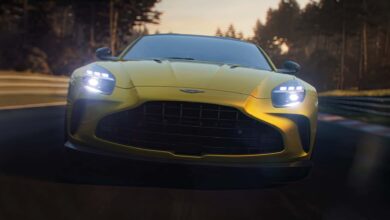Why Australia is enjoying an electric vehicle price war

Some have called it the Tesla graveyard – hundreds of new electric cars parked at the Port of Melbourne, awaiting owners.
Critics argue the scene is a sign that Australia’s soaring electric vehicle sales have finally hit a speed bump and are slowing as they have done in other nations.
But industry experts and a report into the global market paint a different picture.
Rather than a graveyard at Australia’s ports, they say the scenes prove Australia is finally becoming a bigger player in the global market for low-emission transport.
They also say Australian drivers are set to benefit from a price war as brands battle for a larger share of the market, and Australia becomes a key target for Chinese automakers facing tariffs in other parts of the world.
The sea of Model 3 and Model Y vehicles is a welcome sight to Tesla Owners Club of Australia national president Peter Thorne, who recalls when the vehicles were hard to acquire and deliveries took months rather than weeks.
“With Teslas today, you put an order in and you’ll get your model faster than you can fill out the paperwork because they’ve got them in the country and inventory is now readily available,” he tells AAP.
“That’s happening for all these electric vehicle brands at the moment, so where it used to be a six-month wait, it’s now six weeks, four weeks or two weeks.”
While the US automaker once provided one of the only electric cars for sale in Australia, it now has significantly more competition.
The increased rivalry has led Tesla to lower its prices, with two major cuts in April alone.
The price of Tesla’s Model Y electric SUV fell from $69,300 in 2023 to $55,900 this year, at just $1000 more than the company’s entry-level Model 3.
Strategic price cuts
“Their cost reductions are very strategic and are designed to sell certain models,” Mr Thorne says.
“BYD are in the same boat and they’re going to have to be really competitive on their costs (to compete).”
Tesla faces strong competition in Australia from Chinese manufacturer BYD which set a record in May with the sale of 1914 vehicles, compared to Tesla’s 3567 cars.
Both brands have cut prices, with BYD dropping the cost of its Atto 3 SUV by more than $3500.
Other companies to reduce electric vehicle prices include MG, Renault, Peugeot, Lotus and GWM, which introduced a permanent $4000 price cut to its Ora to make it Australia’s cheapest electric car.
Discounts range from $49,010 on the luxury Lotus Eletre to including on-road charges with the BYD Seal Premium.
Australian Electric Vehicle Association national president Chris Jones says the changes will ultimately benefit motorists considering their vehicle options.
EVs are getting cheaper
“What we are seeing is a price war and new EVs are getting cheaper,” he says.
Dr Jones says intense competition is powering the trend as traditional brands expand into the market and more Chinese brands launch cars in Australia.
“China is making good, cheap and abundant EVs,” he says.
“They’ve got a willing market in Australia and we don’t have a problem with Chinese-made EVs – we love them.
“Tesla is trying to find a way to sell in this market and they’re going to have to come up with a lower-price, lower-spec vehicle that competes at the lower end.”
Ten Chinese vehicle brands have confirmed plans to launch electric cars in Australia in coming months including Leapmotor, Zeekr, GAC Motor, Geely Auto and Skywell.
But Swinburne University future urban mobility professor Hussein Dia says Chinese automakers could target Australian motorists more aggressively in the future after the European Union announced higher tariffs on their vehicles.
Charges of up to 38.1 per cent will be added to Chinese-made vehicles imported to Europe from July to support its local manufacturing industry.
As Australia no longer has a local industry to protect, Prof Dia says it does not need similar tariffs and Chinese brands could seek to bring more of their vehicles into the country.
“We have a lot of luxury EVs for sale now, and higher-end SUVs,” he says.
“What we’ve seen from China is the small to medium EVs, which is what a lot of people want to buy.”
Having a larger range of battery-powered vehicles for sale in Australia, he says, will help fuel their popularity, which is still growing although not at the same rate as 2023.
Global EV sales to rise 20 pct in 2024
The BloombergNEF Electric Vehicle Outlook 2024 report released on Thursday finds EV sales are expected to rise to 20 per cent in 2024 while fuel vehicle sales peaked in 2017.
But electric cars are experiencing different growth rates in different countries, with sales down in Italy and Japan as they soar in the UK, France, China and India.
“Electric vehicle markets around the world are not all travelling in the same direction or at the same speed in 2024,” the report says.
“Sales of EVs continue to rise globally but some markets are experiencing a significant slowdown.”
Figures from the Federal Chamber of Automotive Industries show electric vehicles made up 8.1 per cent of all new car sales in May but sales were up by 26 per cent rather than the 161 per cent rise recorded in 2023.
Prof Dia says both local and global sales trends indicate electric vehicles will keep charging ahead in Australia, just at a slower pace.
“In Australia, we keep seeing increases,” he says.
“I think it will stay steady, which means we won’t see the same exponential growth as last year.”
SOME ELECTRIC CAR PRICE CUTS IN AUSTRALIA
Tesla Model 3: Down $4000 to $54,900 (RWD model)
Tesla Model Y: Down $5000 to $55,900 (RWD model)
BYD Seal Premium: Now includes govt charges at $58,798
BYD Atto 3 Standard: Down $3512 to $44,499
Lotus Eletre: Down $49,010 to $189,990
GWM Ora: Down $4000 to $35,990 inc. govt charges
MG ZS EV: Down $2000 to $39,990 inc. govt charges
Renault Megane E-Tech: Down $10,000 to $54,990 until June 30
Peugeot ePartner van: Down $10,000 to $49,990 until June 30 inc. govt charges
See The Driven’s EV Models page for a breakdown of all models available in Australia, and their prices.
And see The Driven’s updated list of the top selling vehicles in the country, month by month, in 2024.
AAP



